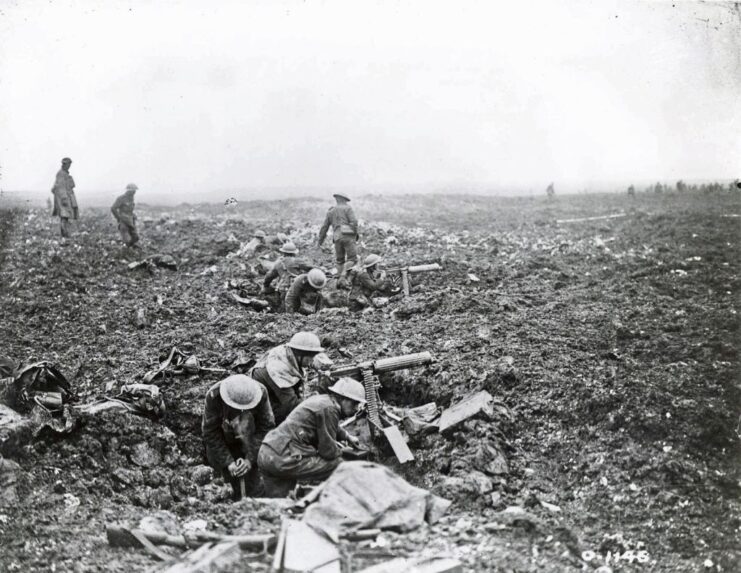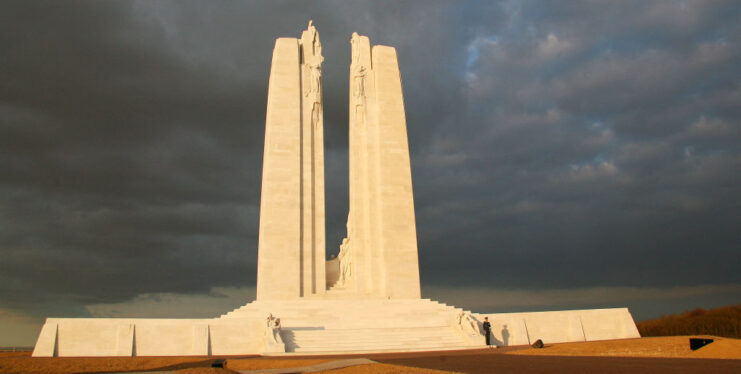The Canadian National Vimy Memorial in France has been vandalized. The monument, dedicated to the Canadian Expeditionary Force soldiers who lost their lives during the First World War, sits at the center of the battlefield park where the Canadian Corps launched their attack during the Battle of Vimy Ridge in 1917.

According to reports, an employee saw someone scrawling graffiti on the Canadian National Vimy Memorial at around 9:00 PM on August 15, 2023. However, they ran away before they could be apprehended.
Speaking with Global News, a source with knowledge of the incident said the graffiti consisted of environmental phrases written in French. The search continues for the individual responsible, with the Canadian government aiding French authorities in the investigation.
Speaking about the vandalism, Canadian Veterans Affairs Minister Ginette Petitpas Taylor said, “I was appalled to hear of the vandalism that took place at the Canadian National Vimy Memorial.” She ended her statement by condemning such actions, saying, “I strongly condemn this and all reprehensible acts of vandalism against cenotaphs, war memorials and other landmarks built to remember and honour the sacrifices made by Canadians in the name of peace.”
Taylor also added that Veterans Affairs Canada is working with the Commonwealth War Graves Commission and Public Services and Procurement Canada to have the graffiti removed from the memorial “as soon as possible.”
The Vimy Foundation also released a statement on Twitter, writing, “We are deeply disheartened to learn about the recent act of vandalism at the Canadian National Vimy Memorial. Such actions disrespect the memory of the 11,285 Canadians missing in France with no known grave, whose names are listed on the monument.”
We were deeply disheartened to learn about the recent act of vandalism at the Canadian National Vimy Memorial. Such actions disrespect the memory of the 11, 285 Canadians missing in France with no known grave, whose names are listed on the monument. https://t.co/hBI3Q4JBQ4
— The Vimy Foundation 🍁 La Fondation Vimy (@vimyfoundation) August 16, 2023
As aforementioned, the Canadian National Vimy Memorial commemorates the sacrifices made by the Canadian soldiers who fought on the Western Front during World War I – in particular, those who lost their lives during the Battle of Vimy Ridge.
The engagement occurred between April 9-12, 1917 and saw 170,000 Allied soldiers – the majority Canadian – take on between 30,000 and 45,000 Germans in what became a historic victory. The German Army held the position, and its location made it particularly difficult to capture.
After weakening the Germans’ positions along the ridge, the Canadian Expeditionary Force launched their assault – the first time the four divisions had fought together. Despite suffering heavy casualties, they came out on top, thanks to extensive planning and the use of innovative tactics and effective artillery support.
For their efforts during the battle, four members of the Canadian Corps were awarded the Victoria Cross, three posthumously.

The Canadian National Vimy Memorial was unveiled at the site of the battle by King Edward VII in July 1936. The ceremony was attended by over 50,000 individuals, 6,200 of whom were from Canada.
The monument aims to honor those who perished during the First World War, with the names of those “with no known grave” inscribed on it. It was designed by Canadian sculptor and architect Walter Seymour Allward, and was constructed around a battlefield known to still contain live munitions from the intense fighting that occurred.
The Canadian National Vimy Memorial was rededicated by Queen Elizabeth II in 2007, after undergoing extensive restoration, and is currently maintained by Veterans Affairs Canada.

More from us: ‘1917’ Producer Bringing Story of Polish Hero Witold Pilecki to the Big Screen
There’s been a rise as of late in vandalism committed by environmental activists. Among the most notable incidents have been the defacing of museum artwork, such as John Constable’s The Hay Wain, Vincent Van Gogh’s Sunflowers and Monet’s Grainstacks.
